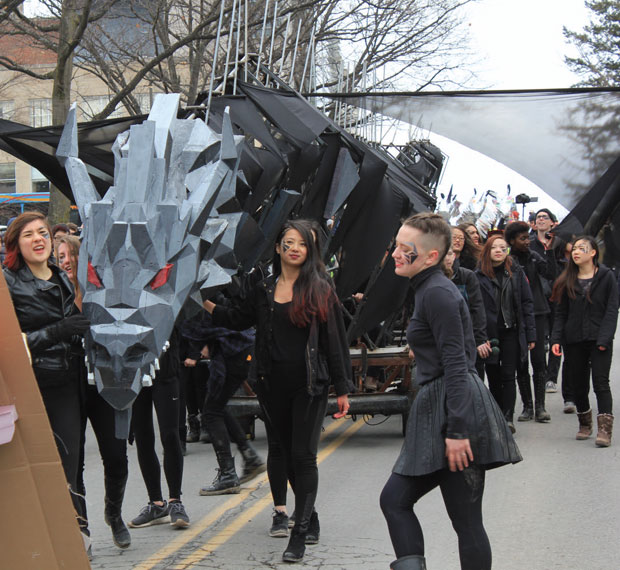
Back in black: Freshman architects guide their creation along the parade route.
“We get to build a dragon,” says first-year architecture student Tara Chen Sue. “I mean, how many people actually get to build a dragon?”
It’s the Tuesday evening before spring break, and Rand Hall is roaring. In the main workshop, freshmen in safety glasses cut lengths of metal—filling the air with an acrid smell, flying sparks, and the ear-splitting racket of a hundred dental drills. In an adjacent room behind a protective curtain, classmates are welding the pieces into diamond shapes that will form beastly ribs and an articulated tail. Down the hall, a dragon’s head is slowly emerging, as an automated milling machine carves foamboard according to a preprogrammed design.
There are only about sixty-seven hours to go before Dragon Day, but the two freshmen serving as the project’s construction managers—Steven Ren and Jeff Drexel—seem surprisingly calm. “If you look at these spines on the back of the dragon, we’re going to have a rope system that runs through the middle, so when you pull it they all go up like a porcupine,” Ren explains over the din, spreading out wide paper sheets bearing architectural drawings. “It’s partly for the visuals, and partly because we have to fit it through a section in the parade where there are low overhanging branches.”
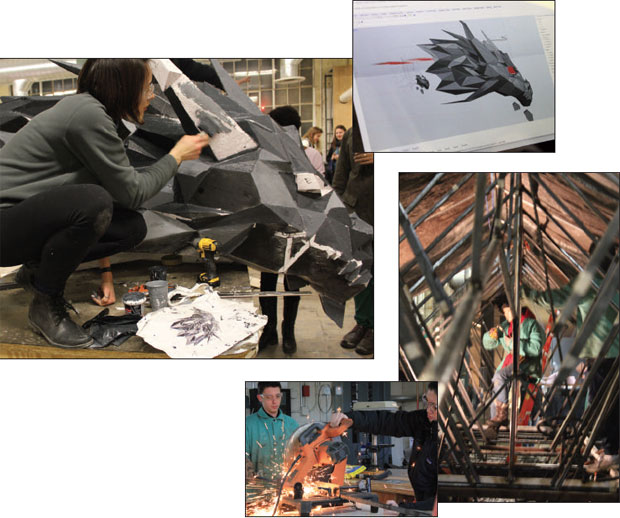
Construction zone (clockwise from above): Painting the dragon’s head; the creature seen in a computer design program known as Rhino; an inside view of the body; and sparks fly as students cut beastly ‘bones.’
Welcome to Dragon Day central. While the students have been planning and designing for weeks, this is where the rubber meets the road: a few madcap days and nights when the mythical beast finally comes together. But thanks to some late-arriving materials, they’re already behind schedule. “Everyone is determined to finish,” says Ren, whose hands are black with carbon from the metal rods. “We’re all excited, and we can pull some late nights if we have to. We’re going to be dead tired on Dragon Day, but I’m pretty happy with the progress we’re making.”
Dragon Day was established more than a century ago—by Willard Straight, Class of 1901, during his senior spring—as a way to celebrate architecture studies at Cornell. Observances varied in the early years, but for decades it has come down to this: first-year architects build a dragon that they parade around campus on the last day of classes before spring break amid much rejoicing, accompanied by upperclassmen clad in costumes that rival Greenwich Village on Halloween. “This is a wonderful tradition,” Katie Kurtz, a first-year sporting bright red lipstick and a pair of safety glasses, says after reporting to Ren and Drexel about the height of the tree branches on Ho Plaza. “It’s the one time of year that the whole university can really see the architecture students and what we’re capable of. I have so many friends who say, ‘I never see you; you’re never outside of Milstein.’”
These days, Dragon Day is a tamer affair than in years past. Once upon a time, the preliminary ritual known as Green Streak—held earlier in the week and echoing Dragon Day’s original connection to St. Patrick’s Day—involved actual nudity. The traditional pranks leading up to the big day are now carefully vetted. And most saliently, the rivalry with student engineers—who build a competing beast, the phoenix—has been ratcheted way down, after some ugliness a couple of decades ago. “Dragon Day used to get really violent. You’d get the dragon and the phoenix together and all kinds of projectiles would start flying, and fistfights would break out,” says Brian Beeners, a longtime staff mentor in the Rand Hall shop who has served as the Dragon Day adviser since 1988. “Those were the old days. It doesn’t happen anymore; everything’s nice and friendly. But in the Eighties and Nineties, there were a lot of people going to the hospital.”
The dragon-phoenix battles of yore—which, it must be said, some on campus are a bit nostalgic for—symbolized the stereotypical rivalry between the two professions. To wit: architects are visionaries, while engineers are practical folk who can actually build things. And though fisticuffs are a thing of the past, the rivalry still exists to some extent. What, for example, does Ren think of the phoenix? “It’s a joke,” he says. “The engineers say that they could use their science and math skills to build an amazing phoenix, but they just don’t have time. And I think that’s, like, slander.”
Later—unable to resist ginning up some drama—CAM’s reporter repeats Ren’s comment to the phoenix crew that’s toiling in a workshop on the outskirts of campus. “Architecture is a joke,” retorts freshman chemical engineer Daniel Vasquez. “People would rather hire civil engineers than architects.”
The Phoenix (Also) Rises

Bird watchers (from top): Engineers shaping wings.
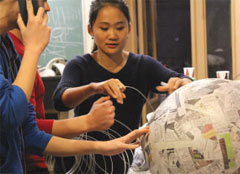
Working on the papier-mâché head.
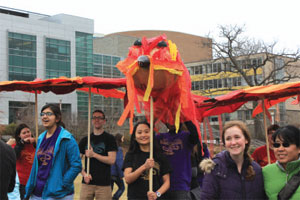
Holding their creation aloft as the dragon marches by.
By Wednesday night, the dragon squad has made serious progress. The metal pieces that will form the skeleton have been cut and laid out along the floor of Rand—ribs in the hallway, tail in an adjacent workshop known as the Annex. The head is now fully formed, though it’s still the foam’s original color, a lavender that’s less “Game of Thrones” than “My Little Pony.” “We just finished milling it, and now we’re figuring out how we’re going to attach it to the body,” says first-year Lucy Flieger, a member of the team in charge of the creature’s noggin. “The head is people’s first impression of the dragon, so we tried to make it really cool. It has complex geometries—they’re all triangular, so there are no curved surfaces on it.”
Outside, at the back of Rand along University Avenue, the students are erecting a tent under which to assemble the growing beast, which will soon be too big to fit inside the building. “It used to have to be better protected,” notes first-year Ainslie Cullen, sporting an official Dragon Day sweatshirt and an artfully shaved patch on the left side of her head, “because the engineers would attack.”
As it happens, CAM is headed over to their workshop tonight. Does Cullen—a co-president of the Dragon Day team—have a message for her engineering counterparts? “Watch out,” she says with a smile, “because the phoenix will fall.” Ren appears, and our rabble-rousing reporter asks him the same question. “Tell them ‘Good luck,’” he says, “but in a sarcastic tone.” Over at the phoenix workshop, in the High Voltage Lab on Mitchell Street outside Collegetown, the scene is much more low key. Rather than assembling a single giant bird, the engineers plan to make separate sections—head, body, wings, and tail—that will be carried on individual poles, adding up to a creature that’s about ten feet long and ten feet wide. The team started making the feathers—red and orange cloth on wire—last week, and the papier-mâché head is in progress. “This has mostly become about keeping up appearances,” says Phoenix Society officer Natalie Diebold ’15, who first heard about the tradition from her dad, engineering alum John Diebold ’81. “Everybody expects us to do something.”
Diebold offers a tour of the cavernous building, where a handful of students are working in small groups. “We’re still figuring out how to put the feathers on,” she says. “Maybe we’ll use duct tape, the engineer’s best friend.” In the far corner, engineering physics student Brandon Daniels ’18 is salvaging wood from the corpse of last year’s phoenix to form this year’s wings. “I think it’s important to represent the healthy rivalry that we have with the architects,” Daniels says, “in a constructive way that benefits all of Cornell.”
But…has he heard the architects’ predictions that the phoenix will fall? He contemplates the question, then says: “If the phoenix is going down, it will triumphantly rise from the ashes.”
By the following night, the phoenix’s spherical head is nearing completion; a team is now working on its moveable beak. As the engineers note, their creation will even have sound effects—a cry that’s a mix of exploding grenades and shrieking hawks. “We’re totally biased, but it’s going to be awesome,” says biological engineering student Fanny Chen ’18, as students snack on pizza and “Escape (The Piña Colada Song)” blares from a nearby laptop. “I’ve been bragging to my friends all week.” On their work table is a bowl of diluted glue, which they’re using to make the papier-mâché beak; a fly is trapped in the milky liquid, desperately swimming for its life. “That,” offers Vasquez, “is the dragon.”
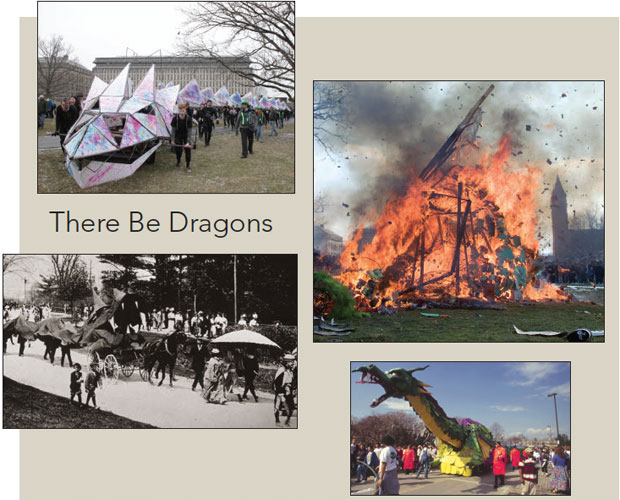
Bygone beasts (clockwise from top right): The oncetraditional dragon immolation, four years before it was banned by a 2009 change in state environmental law; a long-necked specimen from 1995; a horse-drawn beast circa 1906; and 2013’s geometric version, decorated with paint flung at it during the parade
An hour later, outside Rand, the dragon’s forty-foot-long body has been assembled on its rolling chassis, formerly the guts of a Seventies-era Volkswagen minibus. The tail—equally long, and articulated so it can undulate—is taking shape. “We have eight sections, and we’re adding them individually to see if they’ll buckle,” says Drexel. “We’ll keep adding those until it can’t support them any longer, so we’ll know what the structural limit is.”
Over in the Annex, the massive head has been painted in imposing shades of black and grey, with only the red eyes left to finish. Nearby, a half-dozen young women crouch on the floor, deftly hand-sewing triangles of stretchy, diaphanous black material onto the wings. “We were slowed down this morning because we couldn’t bring the arc welders outside—it was raining really hard, and we can’t have the metal in any water—but now we’re ahead of schedule,” Drexel says, as classmates walk by carrying towering stacks of pizza boxes. “The most difficult thing right now is to make sure that each of the joints that pivot on the tail are aligned, because if they’re not parallel, they won’t move. That’s what’s taking the most time.”
Throughout Rand, upperclassmen are hard at work on their costumes, many of them group efforts: a three-man Viking ship; a six-pack of beer made of trash cans covered in duct tape; a dozen donuts crafted from pool floaties. Second-year Sisi Yu stops spray-painting a donut long enough to declare that Dragon Day “is like Slope Day for architecture students.” Third-years Alex Zink and Vinny Portonovo, who are going as red and green crayons (mislabeled, in honor of the fact that they’re both color blind), note that the comparison isn’t hyperbole. In fact, they explain, many architecture students have major presentations due on and around the last day of classes, so they can’t attend Slope Day. “Dragon Day is a way for us to bond as a class,” says Portonovo, “and to come together as architects.” Down the hall, Cullen is sitting at a sewing machine, doggedly producing more pieces of dragon skin. Is she resigned to an all-nighter? “I promised my mom,” she says, “that I’d sleep for an hour and a half.”
When the clock strikes one on Friday, it’s showtime. The completed dragon rolls out from behind Rand and around the corner onto East Avenue, guided by black-clad freshmen shouting the traditional chant: “Dragon, dragon, dragon! Oy, oy, oy!” After negotiating the narrow channel behind Goldwin Smith—where the Klarman Hall construction has reduced the road to one lane—the wings unfold, and the beast emerges in its full glory.
As CUPD officers and green-vested volunteers wrangle the crowds, the parade turns right onto Campus Road. While the dragon is the main attraction, the costumes are a close second. To name just a few: there’s a miniature Hot Truck; an iPhone; a vintage Playboy; a giant pair of Lululemon yoga pants; a cadre of Cornell-specific Monopoly cards; a Chipotle burrito; a Starbucks coffee cup; and a McGraw Tower made entirely of beer boxes, its occupant seeming to have partaken deeply of their contents. While the event may not be the bacchanalia of years past, the atmosphere is decidedly …festive. “I’m sober! I’m sober again!” a student dressed as a space alien declares, to no one in particular. “Why am I sober?”
As the parade passes the Engineering Quad, the architects chant, “The phoenix will fall!” and then, “Where’s the phoenix?” The immortal bird in question is parked next to the quad’s sundial, held aloft by a half-dozen of its creators. Though it has to stay on the sidelines—meaning that many spectators miss it entirely—it has come together in fine fashion, doing the engineers proud. Bringing up the parade’s rear is a herd of silver unicorns, made by physics students wanting in on the fun. (“Of the mythical creatures from which you could choose,” explains third-year grad student Neal Reynolds, “we thought the unicorn would be easily recognizable.”)
The dragon clears the trees on Ho Plaza and makes its way to the Arts Quad for the grand finale. The freshmen tear off its fabric skin, then run the traditional laps around it. The costumed upperclassmen are constrained by a ring of yellow caution tape until the freshmen chant, “Let them in!” The barrier falls, and the colorfully clad masses join the whirlwind.
When the ruckus finally dies down, the dragon returns to its birthplace behind Rand—where students immediately get to work tearing apart what they’ve so carefully constructed. “Everything went so smoothly this year,” observes Rand shop assistant Chris Oliver, doffing his costume as he prepares to oversee the dismantling. “In the past the dragon has broken in half during the parade, or the head has fallen off. This year was without any incidents, and it was really fun. It was a great Dragon Day,” he says, grinning as he raises his voice so the freshmen can hear, “and the best dragon ever.”
Photos by Lisa Banlaki Frank
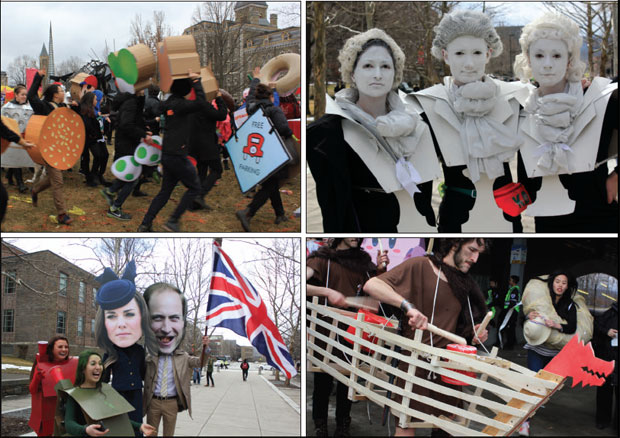
Halloween in March (clockwise from top left): Costumed upperclassmen run circles around the dragon; students clad as a trio of classical composers; a ship manned by drumming Vikings; and British royals meet Monopoly houses.


